200th Anniversary of RNLI, Part 1 - Lifeboats
Issue date: 1st July 2024
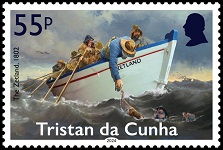 |
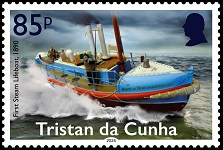 |
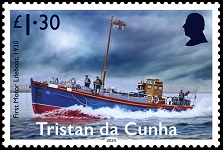 |
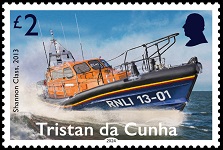 |
| 202403 | Mint Stamps (55p, 85p, £1.30, £2.00) | £4.70 | Shop > |
| 202404 | First Day Cover (with 55p, 85p, £1.30, £2.00 stamps) | £5.90 |
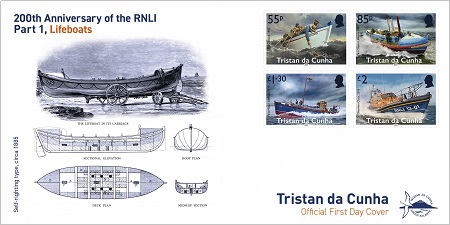
The Royal National Lifeboat Institution (RNLI)
The creation of a service dedicated to the saving of lives at sea was the vision of Sir William Hillary. In the early 19th Century there was an average of 1,800 shipwrecks a year around the coasts of the UK, a risk that was simply accepted as an inevitable part of life at sea.
In 1823 Hillary proposed the creation of a lifeboat service manned by trained crews dedicated to the saving of lives and property from shipwrecks and vessels in distress. When the Admiralty refused to help, Hillary appealed to the philanthropic members of London society. His campaign rapidly gathered momentum resulting in an inaugural public meeting on 4 March 1824 at the City of London Tavern, Bishopsgate. With King George IV granting his patronage the Royal National Institution for the Preservation of Life from Shipwreck was formed. In 1854 the Institution's name was changed to the Royal National Lifeboat Institution, the RNLI, as it is known today.
The story of the RNLI is one of courage and dedication. Since the charity launched its first lifeboat in 1824, the RNLI has saved more than 146,000 lives at sea.
As an Island Nation, Tristan da Cunha is acutely aware of maritime hazards. Tristan has no official Lifeboat service, but the island archipelago has seen many shipwrecks over the years. In fact, many of the first settlers were people saved from a shipwreck. They were so captivated by the island that they stayed and become part of the settlement. The population has repeatedly shown its willingness to aid those in peril on the seas, despite great personal risk.
Tristan has chosen to release two issues to celebrate the 200th Anniversary of the creation of the RNLI. Part 1 depicts various rescue boats used by the RNLI during its history. Part 2 depicts Tristan Rescue Boats that have been used over the years.
Description of the Stamps
55p - The Zetland 1802 - The Zetland is the oldest surviving lifeboat. Public apathy in regard to shipwrecks was temporarily swept away in 1789 by the wreck of a ship called Adventure. This vessel was stranded during a violent storm only 300 yards from the shore. Her crew dropped, one by one, into the raging breakers in the presence of thousands of spectators, none of whom dared to put off in an ordinary boat to attempt a rescue. The disaster inspired a lifeboat design competition with a reward of 2 guineas (i.e. £2.10) for the best design.
Among the entrants were Parish Clerk William Wouldhave and Boatbuilder Henry Francis Greathead, both from South Shields. Neither design was an outright winner. Instead, the committee asked Henry Greathead, who went on to become known as the inventor of the lifeboat, to build a boat using ideas from both designs. The Zetland is Greathead's only surviving original type lifeboat. Built in 1802, she saved over 500 lives during her 78 years of service.
85p - First Steam Lifeboat, 1890 - The RNLI's early pulling and sailing lifeboats struggled in heavy seas. Steam had transformed Britain's industrial landscape but tending a coal-fired boiler in a boat that is pitching and rolling in heavy seas would not be straightforward.
Sixty years after the idea was first mooted by Sir William Hillary, the Duke of Northumberland went into service in September 1890. Duke of Northumberland used waterjets instead of propellors. Three hydraulic steam-driven lifeboats were in service for over 40 years and saved 570 lives.
£1.30 - First Motor Lifeboat, 1930 - The first fast motor lifeboat was designed to reach casualties rapidly. Sir William Hillary, named after the RNLI's founder, was developed in response to an increasing number of aircraft flying over the Channel, and coming down at sea.
The new lifeboat, powered by two 375hp petrol engines, had a top speed of around 18 knots, making her nearly twice as fast as other motor lifeboats of her time.
She was the first lifeboat to have a cabin. She was equipped with jets for spraying fire-extinguishing fluid and could accommodate 50 casualties below deck.
£2.00 - Shannon Class, 2013 - The RNLI's first Shannon class lifeboat was named Jock and Annie Slater, after a former RNLI Chairman, Sir Jock Slater, and his wife, Lady Annie Slater.
The Shannon class is the first modern RNLI all-weather lifeboat to be powered by waterjets instead of propellers, making her fast with speeds up to 25 knots, and agile.
She is self-righting and can endure up to 10 hours in extreme sea conditions. She is highly manoeuvrable even in shallower waters, and her Systems and Information Management System (SIMs) lets crew monitor, control and operate many of the boat's systems from the safety of their seat.
FDC - Self-right Type Lifeboat, c.1885 - Illustrations from a magazine of the time.
Technical Specifications
| Designer: | Andrew Robinson | Printer: | Cartor |
| Stamp size: | 42 x 28mm | Perforation: | 13¼ x 13½ per 2cms |
| Process: | Stochastic lithography | Sheet Layout: | 10 |
| Production Co-ordination: | Creative Direction (Worldwide) Ltd | ||
